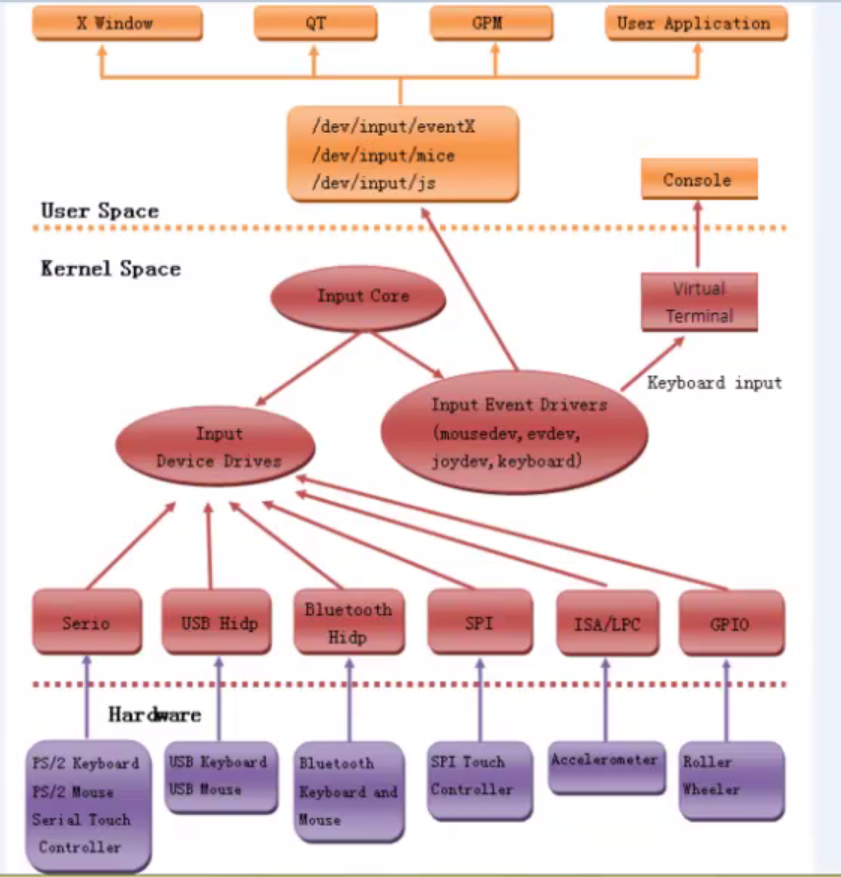Linux input子系统学习总结(一)---- 三个重要的结构体
一 、 总体架构 图

上层是图形界面和应用程序,通过监听设备节点,获取用户相应的输入事件,根据输入事件来做出相应的反应;eventX (X从0开始)表示 按键事件,mice 表示鼠标事件
Input core --- input 核心
Input event drivers --- input事件驱动(mousedev 、 evdev、keyboard)
Input device drivers --- input设备驱动(触摸屏、键盘、鼠标)

三个重要的结构体:
代码路径: include\linux\input.h (基于kernel4.0)
1 struct input_dev { ///代表 input 设备 2 const char *name; /// 设备名称 3 const char *phys; ////设备在系统结构中的物理路径 4 const char *uniq; ///设备的唯一标识符 5 struct input_id id; ///描述硬件设备属性的 ID 6 7 unsigned long propbit[BITS_TO_LONGS(INPUT_PROP_CNT)];/// INPUT_PROP_CNT--0x20 ,一个long包含32bit,所以 propbit[1] 8 9 unsigned long evbit[BITS_TO_LONGS(EV_CNT)]; ///设备支持的事件类型 10 unsigned long keybit[BITS_TO_LONGS(KEY_CNT)]; 11 unsigned long relbit[BITS_TO_LONGS(REL_CNT)]; 12 unsigned long absbit[BITS_TO_LONGS(ABS_CNT)]; 13 unsigned long mscbit[BITS_TO_LONGS(MSC_CNT)]; 14 unsigned long ledbit[BITS_TO_LONGS(LED_CNT)]; 15 unsigned long sndbit[BITS_TO_LONGS(SND_CNT)]; 16 unsigned long ffbit[BITS_TO_LONGS(FF_CNT)]; 17 unsigned long swbit[BITS_TO_LONGS(SW_CNT)]; 18 19 unsigned int hint_events_per_packet; 20 21 unsigned int keycodemax; 22 unsigned int keycodesize; 23 void *keycode; 24 25 int (*setkeycode)(struct input_dev *dev, 26 const struct input_keymap_entry *ke, 27 unsigned int *old_keycode); 28 int (*getkeycode)(struct input_dev *dev, 29 struct input_keymap_entry *ke); 30 31 struct ff_device *ff; 32 33 unsigned int repeat_key; 34 struct timer_list timer; 35 36 int rep[REP_CNT]; 37 38 struct input_mt *mt; 39 40 struct input_absinfo *absinfo; 41 42 unsigned long key[BITS_TO_LONGS(KEY_CNT)]; 43 unsigned long led[BITS_TO_LONGS(LED_CNT)]; 44 unsigned long snd[BITS_TO_LONGS(SND_CNT)]; 45 unsigned long sw[BITS_TO_LONGS(SW_CNT)]; 46 47 int (*open)(struct input_dev *dev);///打开设备 48 void (*close)(struct input_dev *dev); 49 int (*flush)(struct input_dev *dev, struct file *file); 50 int (*event)(struct input_dev *dev, unsigned int type, unsigned int code, int value); 51 52 struct input_handle __rcu *grab; 53 54 spinlock_t event_lock; 55 struct mutex mutex; 56 57 unsigned int users; 58 bool going_away; 59 60 struct device dev;///每个设备的基类 61 62 struct list_head h_list; 63 struct list_head node; 64 65 unsigned int num_vals; 66 unsigned int max_vals; 67 struct input_value *vals; 68 69 bool devres_managed; 70 };
1 struct input_handler {///代表输入设备的处理方法 2 3 void *private; 4 5 void (*event)(struct input_handle *handle, unsigned int type, unsigned int code, int value); 6 void (*events)(struct input_handle *handle, 7 const struct input_value *vals, unsigned int count); 8 bool (*filter)(struct input_handle *handle, unsigned int type, unsigned int code, int value);/// 9 bool (*match)(struct input_handler *handler, struct input_dev *dev); 10 int (*connect)(struct input_handler *handler, struct input_dev *dev, const struct input_device_id *id); 11 void (*disconnect)(struct input_handle *handle); 12 void (*start)(struct input_handle *handle); 13 14 bool legacy_minors; ///是否遗留次设备号 15 int minor;///次设备号 16 const char *name;///名称 17 18 const struct input_device_id *id_table;/// input_device 和 input_handle 通过id_table 进行匹配 19 20 struct list_head h_list; 21 struct list_head node; 22 };
Match :在设备id 和handler 的id_table 匹配成功的时候调用; (called after comparing device's id with handler's id_table to perform fine-grained matching between device and handler)
Connect : 当一个handle 匹配到一个device 的时候执行(called when attaching a handler to an input device)
Start :当input 核心执行完 connect 以后调用(called by input core right after connect() method)
1 struct input_handle { //// 用来关联input_dev 和 input_handler (links input device with an input handler) 2 3 void *private;///私有成员变量 4 5 int open; 6 const char *name; 7 8 struct input_dev *dev; 9 struct input_handler *handler; 10 11 struct list_head d_node; 12 struct list_head h_node; 13 };
如图,横轴表示一系列的input 设备,纵轴表示事件驱动event,中间的紫色圆点代表input_handle,通过input_handle来关联设备驱动和事件驱动

(注:以上图片均来自麦子学院 金鑫老师的课程,在此对其辛勤付出和无私分享表示真挚的感谢!)





